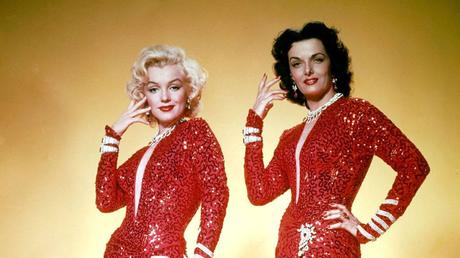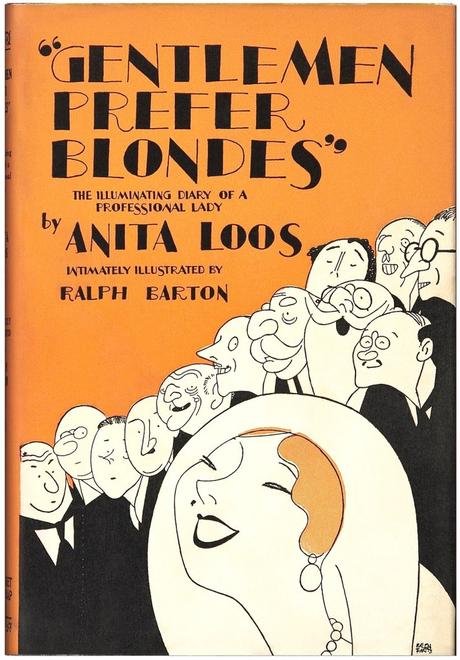
Even if someone has never seen a Marilyn Monroe movie, they’re likely familiar with one of two images of her: the white subway dress scene from The Seven Year Itch or wearing the pink dress from the “Diamonds are a Girl’s Best Friend” scene from Gentlemen Prefer Blondes. Gentlemen Prefer Blondes is certainly one of the first Marilyn Monroe movies I ever remember seeing and it remains one of my all-time favorite movies.
I first saw the movie pretty early on in my process of discovering classic Hollywood and instantly loved it for Marilyn and Jane Russell. But over the years, I also grew to appreciate the work of Anita Loos, who wrote the original story Gentlemen Prefer Blondes, first published in 1925. So, naturally, the book version had been on my to-read list for a very long time.
Book & Movie Differences
The 1953 film version of Gentlemen Prefer Blondes is a very loose adaptation of the original story. The movie is closer to the stage musical adaptation, which debuted in 1949, but there are still plenty of differences between the stage musical and the film version. (It’s worth noting that neither the 1953 film or the 1949 stage musical were the first times the story had been adapted for either medium. Gentlemen Prefer Blondes had previously been adapted into a movie released in 1928, which is now considered a lost film. It had also been previously been adapted for the stage as a straight comedy, which premiered in 1926.) But this is the kind of book that makes it easy to take liberties with the material.
First of all, the book is not structured like a traditional narrative novel. Instead, it’s a series of fictional diary entries by Lorelei Lee. Several side characters and events in the book are completely cut for the movie to make it a more focused story. One of the cut events includes Lorelei and Dorothy stopping in England on their way to France and meeting the Prince of Wales, only for Lorelei to be horrified by Dorothy using slang around the Prince. There’s also one story about Lorelei meeting Sigmund Freud, who is unable to analyze her because of her lack of inhibitions, and another story about Lorelei throwing her own belated debutante debut party.

In all versions of the story, Lorelei’s desire to own a diamond tiara is a significant source of drama. In both the movie and the stage musical, it’s because the tiara belonged to Lady Beekman. But in the book, that tiara never belonged to Lady Beekman. It originally belonged to an unrelated person who was looking to sell it. Since Lorelei couldn’t afford it herself or get Gus to pay for it, she gets Francis Beekman to buy it for her instead. But when Lady Beekman found out her husband had paid for a tiara and knew perfectly well he hadn’t bought any jewelry for her since her wedding ring, she sent some lawyers after Lorelei to get the tiara. But when the lawyers meet up with Lorelei and Dorothy, they let the lawyers have the fun of taking them out on the town since they’d be billing Mrs. Beekman for it anyway as part of their job and Lorelei makes sure they take a replica tiara back instead.
Lorelei’s background is a bit different in the movie than we see in the book. The movie version of Lorelei Lee is a working showgirl, but in the book, she had worked in films before being “educated” by Gus Eisman, who had asked her to give up her film career. The movie also makes absolutely no mention of an incident described in the book where Lorelei attempted to shoot her boss after he tried to assault her, but since it was an act of self-defense, she was free to go.
One change for the movie that I’d really love to hear the reasoning for is the decision to make Mr. Spoffard into a child. In both the book and the stage musical version, Mr. Spoffard is, indeed, an actual adult. The book version of Mr. Spoffard is part of a wealthy, conservative family and is a member of a censorship board that goes through movies and cuts out anything they deem morally objectionable.
Is the Book Worth Reading?

I was quite impressed by how well the book version of Gentlemen Prefer Blondes holds up today. Nearly a century after its initial publication, the smart writing by Anita Loos remains a real pleasure to read. On the whole, the book — like the movie — is light and pure fun; often laugh-out-loud funny. If you’re looking for a good beach read, Gentlemen Prefer Blondes is perfect.
Even though the book has very deep roots in the 1920s, complete with references to people like D.W. Griffith, Rudolph Valentino, and Peggy Hopkins Joyce, much of the humor and character tropes are timeless. For example, Lorelei often thinks she’s classier and more refined than Dorothy so it’s always going to be funny to see Lorelei repeatedly be mortified by Dorothy’s sassy, wisecracking nature. (It’s very easy to see why Jane Russell was cast as Dorothy in the movie.) The book also makes fun of people who scour popular media just looking for things to get into a moral outrage about, and there are certainly still plenty of those around today. The fact that the 1953 version of the movie is fully separated from the original 1920s setting and still works very well is a great reflection of how much of it is timeless.
It also helps that Lorelei isn’t actually a dumb blonde, as people may be quick to dismiss her as. While the book makes fun of her self-perception of being a bit more sophisticated than she really is, she’s often shown as being clever and astute in her own distinctive manner.
This review is part of the 2022 Classic Film Summer Reading Challenge hosted by Out of the Past. For more reviews on books related to classic film, be sure to follow the #ClassicFilmReading hashtag on social media.
